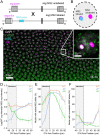Shadow enhancers modulate distinct transcriptional parameters that differentially effect downstream patterning events
- PMID: 36264246
- PMCID: PMC9687063
- DOI: 10.1242/dev.200940
Shadow enhancers modulate distinct transcriptional parameters that differentially effect downstream patterning events
Abstract
Transcription in the early Drosophila blastoderm is coordinated by the collective action of hundreds of enhancers. Many genes are controlled by so-called 'shadow enhancers', which provide resilience to environment or genetic insult, allowing the embryo to robustly generate a precise transcriptional pattern. Emerging evidence suggests that many shadow enhancer pairs do not drive identical expression patterns, but the biological significance of this remains unclear. In this study, we characterize the shadow enhancer pair controlling the gene short gastrulation (sog). We removed either the intronic proximal enhancer or the upstream distal enhancer and monitored sog transcriptional kinetics. Notably, each enhancer differs in sog spatial expression, timing of activation and RNA Polymerase II loading rates. In addition, modeling of individual enhancer activities demonstrates that these enhancers integrate activation and repression signals differently. Whereas activation is due to the sum of the two enhancer activities, repression appears to depend on synergistic effects between enhancers. Finally, we examined the downstream signaling consequences resulting from the loss of either enhancer, and found changes in tissue patterning that can be explained by the differences in transcriptional kinetics measured.
Keywords: Drosophila; MS2 live imaging; Morphogen gradient; Shadow enhancers; Transcriptional kinetics.
© 2022. Published by The Company of Biologists Ltd.
Conflict of interest statement
Competing interests The authors declare no competing or financial interests.
Figures






Similar articles
-
Shadow enhancers can suppress input transcription factor noise through distinct regulatory logic.Elife. 2020 Aug 17;9:e59351. doi: 10.7554/eLife.59351. Elife. 2020. PMID: 32804082 Free PMC article.
-
Transcriptional activity of the short gastrulation primary enhancer in the ventral midline requires its early activity in the presumptive neurogenic ectoderm.BMB Rep. 2016 Oct;49(10):572-577. doi: 10.5483/bmbrep.2016.49.10.119. BMB Rep. 2016. PMID: 27616358 Free PMC article.
-
Krüppel Expression Levels Are Maintained through Compensatory Evolution of Shadow Enhancers.Cell Rep. 2015 Sep 22;12(11):1740-7. doi: 10.1016/j.celrep.2015.08.021. Epub 2015 Sep 3. Cell Rep. 2015. PMID: 26344774 Free PMC article.
-
Evolution of insect dorsoventral patterning mechanisms.Cold Spring Harb Symp Quant Biol. 2009;74:275-9. doi: 10.1101/sqb.2009.74.021. Epub 2009 Oct 20. Cold Spring Harb Symp Quant Biol. 2009. PMID: 19843594 Free PMC article. Review.
-
Enhancer redundancy in development and disease.Nat Rev Genet. 2021 May;22(5):324-336. doi: 10.1038/s41576-020-00311-x. Epub 2021 Jan 12. Nat Rev Genet. 2021. PMID: 33442000 Free PMC article. Review.
Cited by
-
Setting the stage for development: the maternal-to-zygotic transition in Drosophila.Genetics. 2023 Oct 4;225(2):iyad142. doi: 10.1093/genetics/iyad142. Genetics. 2023. PMID: 37616526 Free PMC article. Review.
-
A simple MiMIC-based approach for tagging endogenous genes to visualise live transcription in Drosophila.Development. 2024 Dec 15;151(24):dev204294. doi: 10.1242/dev.204294. Epub 2024 Dec 16. Development. 2024. PMID: 39584418 Free PMC article.
-
Coordinated active repression operates via transcription factor cooperativity and multiple inactive promoter states in a developing organism.Nat Commun. 2025 Sep 1;16(1):8157. doi: 10.1038/s41467-025-62907-3. Nat Commun. 2025. PMID: 40890123 Free PMC article.
-
Biological roles of enhancer RNA m6A modification and its implications in cancer.Cell Commun Signal. 2025 May 30;23(1):254. doi: 10.1186/s12964-025-02254-4. Cell Commun Signal. 2025. PMID: 40448182 Free PMC article. Review.
-
Optogenetic manipulation of nuclear Dorsal reveals temporal requirements and consequences for transcription.Development. 2025 Mar 15;152(6):dev204706. doi: 10.1242/dev.204706. Epub 2025 Mar 31. Development. 2025. PMID: 40018801 Free PMC article.
References
Publication types
MeSH terms
Substances
Grants and funding
LinkOut - more resources
Full Text Sources
Molecular Biology Databases

